Archive
They Might Want to Film the Next Nat Geo Show at My Supermarket

Please believe me when I say that I have seen more wildlife in the supermarkets that I have either worked in or shopped at than most people might see on a nightly Nat Geo broadcast. There are various reasons why wildlife is more noticeable in today’s supermarket. The readers of this blog should understand that I certainly do not purposely seek out stores to shop at where animals roam freely nor do or did I only work for companies that have bizarre sanitation practices although the Uzzi family stores come pretty close to strange cleaning practices. Perhaps the purpose of this post is that by sharing some of my wildlife experiences with the readers of this blog than together we can hold our local supermarket to a higher level of cleanliness and sanitary conditions that will further ensure the safety of the food that we buy in our stores.

For some reason my recollection of going to the supermarket as s a child was not filled with images of animals and assorted wildlife lurking under counters or shelves to startle and scare me. Nor while I was growing up, some will possibly say that based on this blog I still haven’t, do I recall running for cover like the crowds did in Hitchcock’s classic film the Birds. Those winged avengers in that film strafed and pecked at the human heads scurrying beneath their glide paths while back then I was just reaching for a box of Frosted Flakes on the shelf and never looked up to see if a bird was circling above me. Surly supermarkets back in the day had the odd attack of fruit flies in the produce department or the lone mouse running under a shelf or case that must have gotten lost on it’s way to Disneyland. No today there is certainly more wildlife in the average supermarket than there used to be perhaps you just have not notice them.

Why is this the case? First of all most supermarkets are not as dutiful about regularly using an exterminator in their stores. It is simply a matter of expense control. No I am not out of mind in stating this is a more common industry practice of treating when there are signs of infestation as opposed to treating to prevent pests. While no store manager wants to be accused of running a dirty or infested store the fact is that chain consolidations and the more prolific role that accountants play in today’s food operation lead to a reduction in store personal who’s duties included cleaning. The reduction in a store cleaning efforts is another reason as to why more wildlife roam the aisles in our stores. In addition it contributes to more bacteria and assorted germs lurking just beneath the surface so to speak.

In addition another reason as to the rise in the wildlife population in today’s supermarkets is that they contain more “fresh” and prepared foods than they did back in the day. Years ago other than produce or meat items most food came in either a box, tray or container. Convenience was king and the microwave ruled the house. In the homes of the day the Food Channel was in it’s infancy and chopping one’s own garlic was not a common household practice. The Foodie had not yet begun it’s rise in the food shopping chain. Consumers were beginning to demand more fresh and prepared foods for their shopping carts and these products were made in the supermarket itself thereby making them a more attractive target for our winged and multiple cell pests. While some industry pundits and observers will scoff at these notions of mine the practices in use today in the supermarket industry, both labor expense control as well as the reduction in store operational expenses, lend credence to the arguments presented in this post. It is one of those ugly hidden truths that no one likes to talk about.

Poor Marvin the mouse for he did not even know what he was getting into when he sensed those juicy bread crumbs laying in the tray of that Bread Slicer in the stores bakery department prep area. Every evening when the bakery department workers had gone home Marvin and his friends could play amongst the bakery machines, ovens and product ingredients. They could eat to their hearts content and then snooze through the day coming out the next evening to eat again.
The particular store that Marvin and his buddies lived in offered their bakery department customers a bread slicing service. The bakery department sales racks were filled with whole loafs of Pumpernickel, Rye and other varieties of fresh baked bread. So a customer would just have to hand the bread that they want to buy to the bakery department associate and they would load it into the Bread Slicer and within a minute the customer would be handed a package of sliced bread. To the neo-Foodie this is a great service and for the older customer it is the way that they want to buy their bread.
Well this bread slicing machine has a metal slide out tray at the base of it where the crumbs from the slicing operation fall into. If the bakery department staff was not diligent about cleaning that tray out every day then the crumbs would accumulate in significant quantities, enough to entice Marvin and friends to come get some carbs.
Now if you ever have an opportunity to see one of these commercial bread slicing machines you will immediately notice the rack of sharp cross cut blades about 2 feet long that does the slicing of the bread. When the machine is running it looks like it could mutilate a human limb into 1/2″ sections without a fuss. Well the point that I would like to make is that in order for Marvin and his friends to get at the tasty morsels of bread crumbs they have to run the gauntlet of these sharp blades. It is a tight space to squeeze through even if you are a mouse and the machine is not running at the time.
Since this was an Uzzi family store it meant that the department head as well as the store manager were constantly being squeezed to reduce their payroll expenditures to almost nothing. When line employees are berated constantly about their payroll hours by an Uzzi type manager they tend to do less on the things that are not noticeable like cleaning and focus more on making sure that there is product on the shelf. In this store the amount of bread crumbs in that metal tray was more like a coating on all of the tray surfaces and there was a good build up of crumbs within the machine to get Marvin’s attention.
On one particular evening Marvin worked his way into the metal crumb catch tray however he never got out, at least alive. Marvin died and the metal crumb tray became his short term coffin for he laid in that tray for some period of time. With Marvin’s decomposing body in the crumb tray the slicer continued to be used for slicing customers bread purchases. Finally after weeks had passed an employee noticed a foul smell coming from the bakery department. It took a bit of exploring but Marvin’s body was located and disposed of. The tray was cleaned out – finally, and the slicer continues to be used to this day.
I am willing to say that no more attention is being paid to keeping that bread crumb tray cleaned out today then it was when Marvin lost his life.

If any story about animal life in the supermarket grosses me out the most it would be the time that a store’s meat case had a layer of maggots in the bottom of it. What I mean by the meat case is the refrigerated display case that customers pick the packages of meat out of to purchase. Yes this really did happen in a store and without proper cleaning procedures it will continue to happen. Please believe me that this is not the first time that this type of infestation has occurred in a supermarket.
The store that I am referring to was not an overtly dirty looking store. It was equipped with older refrigerated product cases that had a history of equipment breakdowns well above the industry average. The reason for these breakdowns were due to the overall age of the cases along with the lack of preventative maintenance practices and a poor effort on the stores departmental staff to actually keep them clean. Again like in the case of Marvin’s demise the meat department staff, being one of the highest hourly rate departments in the store, was pressured to keep their payroll costs down so cleaning became more of an after thought.
So packages of meat that were displayed in this particular case left traces of meat product, juices and blood in the lower grate/grill area of the case. With the older case not keeping a cold enough temperature to inhibit this type of bug growth coupled with poor cleaning and sanitation practices by the staff maggots began to thrive in the display case. The bottom of the case was lined with a sheet of vented honeycomb type plastic mesh, like the type found in most supermarkets, which allowed the maggots to nest under this liner. Since the liner was not regularly removed and cleaned under the product that was layered on top of it provided more sustenance for the maggots to thrive on.
Such disgusting sanitary practices from businesses that we buy our food from who sometimes fail to recognize the obligations they have to keep their premises sanitary in order to protect the public’s health should never be tolerated. When these business do not live up to their responsibilities people can get sick. If you as a consumer notice something unsanitary in your local store report it to store management. If nothing is done about it right away do two things. First contact your local health department and lodge a complaint. Second stop shopping at that store because they are endangering your health. Uzzi family type sanitation practices should never be tolerated.
AB
Copyright 2010 @ Supermarket Stories
If I Checkout My Own Groceries Why Am I Not Being Paid or at Least Given a Discount?
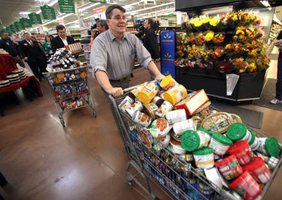
Foodie or regular shopper. Shopping solo, with a wing man or you have the whole bloody family with you. Let’s face it by the time you have selected your items, run the gauntlet of the perishable departments and pole vaulted over 2 dozen product displays strategically located in those narrow store aisles you the shopper are ready to get the heck out of the store. Now there is the rub. As you swiftly move across the front of your local supermarket pushing your loaded shopping basket with bad wheels frantically looking for the friendly face of a cashier to take the burden of checking out and bagging your purchases off of you suddenly you realize that there are no friendly faces available. Your choice is to wait in a long line behind other shoppers who have populated the 2 or 3 checkout lanes that are actually staffed at that particular moment in time or check your grocery purchases out yourself. Please note that there are now hybrid alternatives to the self-checkout of your groceries including a scan as you go device however in this post we will stick to the either or choice dilemma for ringing up your groceries.
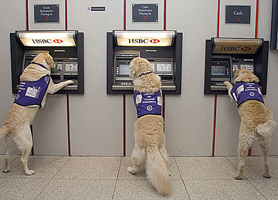
Some pundits might at this point begin to draw comparisons between the similarities of the history of retail banking ATM’s and self-checkout registers in the supermarket. I will briefly say that yes years ago one had to go into a bank branch to make deposits and make withdrawals. Waiting on-line was the norm however I believe the staffing levels in the banks back then were at a much higher level than let’s say a funeral home information booth at a run for life marathon. ATM’s at first allowed the consumer to have access to the cash in their respective accounts 24 hours a day 7 days a week. Yes this was a win for the consumer. No real heavy lifting here so to speak and no extra charges or fees. As time went by did the banks profit by reducing their branch staffing levels? Yes. Later as the consumers need for cash lessened even the ATM’s began to lose some of its luster in the eyes of the banking consumer. The two situations are different as I will now explain within the balance of this post.
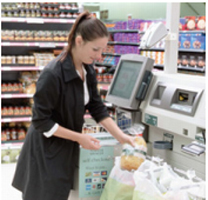
The basic point to be made in defense of the title of this post is that any customer in any supermarket that scans, bags and pays for their supermarket product purchases is saving that supermarket money by reducing the stores labor expenses. Yes a weak case can be made that with the initial capitalized costs of these self-checkout registers, $25 to $60 thousand each, along with their annual operating costs, there is no savings to the store. Again some might suggest that these upfront cost are more expensive than what it would take to staff a regular register with an employee and that the reason that stores deploy self-checkouts is really because of customer service demands. Well let me set everyone straight on the manned register versus self-checkout register expense point. It is my professional opinion, based on years of experience, that the majority of self-checkout register systems in use in today’s supermarket are less expensive to operate than a register manned by an employee. There is no other reason why the industry has embraced these machines except for the fact that it reduces their labor expenses.
Okay point number two. It is a fallacy to believe that supermarket chains, operators and business owners implement self-checkout registers because of the need to provide customer service. Let’s stop for a moment and revisit that last sentence. Now that we have taken a moment to digest this broad claim of mine let’s take a closer look at it.
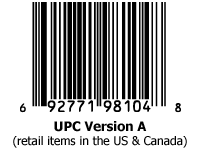
Once again if we all get into the proverbial time machine and go back to late 1970’s or early 1980’s we would see that most supermarkets and grocery stores did not have cash registers that scanned the bar codes or the UPC codes on products. Yes at that point in time a number of national and local chains had begun rolling out scanning cash register systems in their stores because the use of this technology would certainly reduce the time it took to ring up a customers order which in turn was a good thing for customer service. No one disagreed with this line of thought. One of the downsides in implementing bar code scanning in a supermarket was the upfront capital costs. Outside of the necessary electrical and communications wiring requirements, along with in most cases the checkout stands themselves which had to be replaced as well, a POS or Point of Sale cash register system could run as much as $10,000 per lane not counting the cost of back office support systems, hardware maintenance and weekly information updates. There were additional benefits to the retailer as well what with availability of sales and profitability reports by product and/or department. Detailed sales analysis in the supermarket at store level had finally arrived. Better and more efficient inventory levels were sure to follow, at least some thought so anyway.
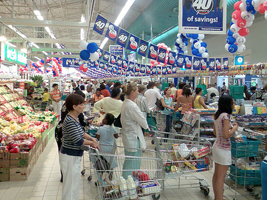
Okay so POS scanning systems slowly made their way into most main stream supermarket throughout the 1980’s and early 1990’s. Some more progressive thinking small independent supermarket operators also adopted this product scanning technology early on when the larger chains were implementing it but by the early 1990’s pretty much all supermarkets had either or where in the process of installing these new “computer” type cash register systems in their stores. They market was forcing all retailers to do this because the customer perceived this type of cash register system as a way to check out quickly at the end of their shopping trip saving them valuable time. Once again retailers benefited from this new cash register technology as well. The belief was that a cashier manning a POS scanning cash register could check out more customers per hour than a cashier who rang up each product by price. With less cashiers required to serve the customer at the front of the store than the labor savings achieved there meant more money/profit going to the bottom line. Of course there were many other benefits for a retailer implementing this technology but that discussion could fill a couple of posts on this blog and is not germane to this particular one.
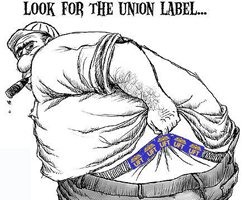
A small side note here back when bar code scanning systems were being implemented in the U.S. supermarket industry labor unions were up in arms about industry management using this new technology. The loss of union jobs was obviously a major reason for their position on challenging the use of these systems for it would lead to lower staffing levels in the store therefore less jobs for their members. Later when self-checkout cash registers began to be implemented in supermarkets there was even less hyperbole emanating from the unions concerning the loss of union jobs because of the reduction in their overall influence in the labor market.
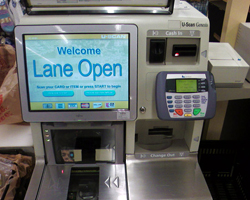
Okay so we can that in bringing bar code scanning cash registers into the supermarket the retail industry had served up improved customer service to their shoppers and at the same time achieved labor savings along with now having access to more detailed inventory/sales reports. To me this sounded like a win-win situation for everyone except organized labor. So now let’s take a closer look at the implementation of self-checkout cash register systems in the U.S. supermarket industry.

Even with the reduction in the presence and strength of organized labor in the U.S. supermarket industry labor costs were one of the three perceived menaces of profitability in the supermarket industry. The others, in no particular order, were the costs of goods or the how much the retailer paid for the products that they sold to their customers. The last threat was the cost of utilities services in a store. As some of you might remember from an earlier posts I believe it was a study by the University of Iowa that stated that 5% of the total consumption of electricity in the U.S. is by supermarkets. At the same time as the implementation of self-checkout cash registers the U.S. supermarket industry was going through a period of consolidation. Larger U.S. national chains were buying up regional supermarket chains. Foreign supermarket chains were buying up U.S. regional chains. Investors were demanding an even higher return on their investments as the technology industry boomed. From a historical standpoint most successful supermarkets of the day averaged a 1.7% net profit margin while the really successful ones averaged 2% or slightly higher of a net profit.
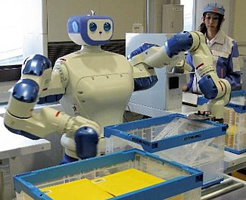
Retail technology vendors began to tease the CEO’s and CFO’s of the supermarket industry by peddling a potential cure for the increasing costs of labor in their checkout operations. This magic pill was the self-checkout cash register system. Just imagine company executives having an employee that never calls in sick, never requires health insurance, works without a break and never asks for a raise they chortled. Remember also that there is no possible way that these mechanical workers will ever ask to join a labor union. Of course these technology vendors had to convince these executives to swallow a tremendously high level of capital expenditures to achieve this labor cost nirvana but they also had a backup plan to get them on board. This plan was to pitch these new mechanical workers as a form of customer service! Yes these devices would be something that customers would be demanding, especially as these retail executives continued to trim the number of workers at the front of their respective operations, so everyone shouted with glee as they drank the Kool Aid.

Obviously I have a certain predisposition to the issue of whether the retail food industry implemented self-checkout cash register systems for labor savings benefits or for customer service reasons – these two reasons are mutually exclusive. As the line in one particular movie went, sorry Kevin Coupe and Mike Sansolo for using the movies for business lesson, “do not piss on my back and tell me that it is raining”.

As a consumer just think of it. You are now ringing up the products that you are purchasing from the store. After ringing them up you are then putting these products in some type of bag that if applicable you will put back in your shopping cart and then take to your vehicle. The first two tasks that were normally done by the supermarket cashier is now being done by the shopper therefore saving the retailer labor costs. If there was a real human ringing up your purchases then there might possibly be an exchange of pleasantries between the two parties along with the potential of a retailer-customer relationship bond being formed. In some cases this bond could contribute to the customer loyalty factor that retailers crave but we will leave this subject on the side of the road for now.
So the point that I am making in the title of this particular post rings true. If I the customer am now doing the work that some employee in a store use to do then why am I not being compensated for my free labor in the form of a discount on my order or a credit on my next one. It is insulting from a customer service standpoint and it is just another example of how businesses today squander marketing and increased sales opportunities by implementing poorly thought out strategies. It is also indicative as to how supermarket retailers view their customers as a whole. Is it a pain to go into a store and do one’s shopping only to find out that there are only a few manned cash registers in which to checkout at? Of course it is. However to be herded over to the self-checkout registers, like lemmings to the sea, is just plain insulting. Worse yet is being told by the retailer that the only reason that they have these type of checkout systems is because that is what we the consumer clamored for. That is simply a lie.
TBC in another Post
AB
Copyright @ 2010 Supermarket Stories
Recent Posts
Categories
Archives
- November 2010 (2)
- October 2010 (10)
Calendar of Posts
| S | M | T | W | T | F | S |
|---|---|---|---|---|---|---|
| 1 | ||||||
| 2 | 3 | 4 | 5 | 6 | 7 | 8 |
| 9 | 10 | 11 | 12 | 13 | 14 | 15 |
| 16 | 17 | 18 | 19 | 20 | 21 | 22 |
| 23 | 24 | 25 | 26 | 27 | 28 | 29 |
| 30 | ||||||